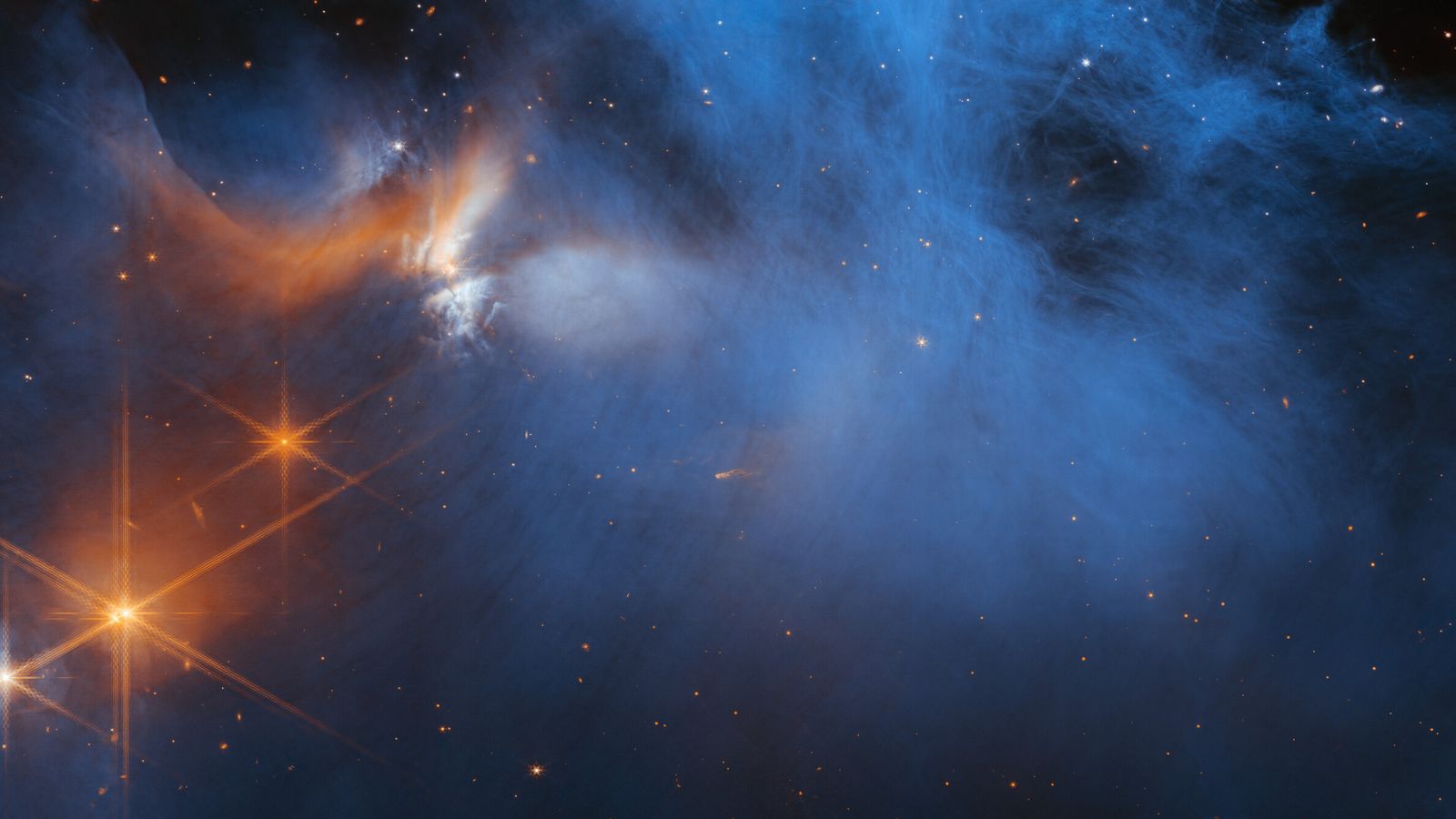NASA’s James Webb Space Telescope finds signs of ‘building blocks for life’ in icy clouds
NASA’s James Webb Space Telescope, which has captured some of the most iconic images of the final frontier in history, sent back detailed shots of a faraway region where temperatures go as low as -270C.
By Tom Acres, technology reporter
Monday 23 January 2023 16:17, UK
This image by the NASA/ESA/CSA James Webb Space Telescope…s Near-InfraRed Camera (NIRCam) features the central region of the Chameleon I dark molecular cloud, which resides 630 light years away. The cold, wispy cloud material (blue, centre) is illuminated in the infrared by the glow of the young, outflowing protostar Ced 110 IRS 4 (orange, upper left). The light from numerous background stars, seen as orange dots behind the cloud, can be used to detect ices in the cloud, which absorb the starlight passing through them… An international team of astronomers has reported the discovery of diverse ices in the darkest, coldest regions of a molecular cloud measured to date by studying this region. This result allows astronomers to examine the simple icy molecules that will be incorporated into future exoplanets, while opening a new window on the origin of more complex molecules that are the first step in the creation of the building blocks of life. [Image Description: A large, dark cloud is contained within the frame. In its top half it is textured like smoke and has wispy gaps, while at the bottom and at the sides it fades gradually out of view. On the left are several orange stars: three each with six large spikes, and one behind the cloud which colours it pale blue and orange. Many tiny stars are visible, and the background is black.]
Image:
Pic: NASA, ESA, CSA, and M. Zamani (ESA/Webb); Science: F. Sun (Steward Observatory), Z. Smith (Open University), and the Ice Age ERS Team
Why you can trust Sky News
Molecular species that form the “building blocks for life” have been found in a deep space region of icy clouds.
Using NASA’s James Webb Space Telescope, a team of astronomers and scientists confirmed the presence of methane and ethanol, as well as small compounds with nitrogen and sulphur.
Sponsored link
Recommended byWhat is Outbrain
autoTRADER.ca
On Earth, sources of methane include emissions from wetlands, oceans, landfills and raising cattle, while most ethanol comes from fermenting starches and sugars.
They were discovered some 500 light years from Earth, in a region where temperatures range from -270C to -250C that had never before been observed.
The international team spent 30 hours observing two areas in the dense and difficult-to-investigate Chameleon I molecular cloud, where dozens of young stars are forming.
NASA’s powerful telescope sent back detailed images and data, from which the so-called Ice Age scientists could identify molecules.
The image at the top of this article shows the central region of Chameleon I, with the cold, wispy cloud in blue, illuminated by the glow of a young star (seen in orange).
It’s the light from that star and others in the background that are used to detect ices in the cloud, which absorb the starlight passing through them.
“This is exciting for two reasons,” Professor Martin McCoustra, an astrochemist, said.
“One is that it makes us more confident in the conditions we’re recreating in our laboratories.
“The second is that these molecules are the materials from which the building blocks for life are made.
“We are increasingly certain that many of the components of the organic soup from which life evolved had an extra-terrestrial origin and were generated as a natural part of the process of forming the sun and solar system.”
The Pillars of Creation are set off in a kaleidoscope of color in NASA’s James Webb Space Telescope’s near-infrared-light view. The pillars look like arches and spires rising out of a desert landscape, but are filled with semi-transparent gas and dust, and ever changing. This is a region where young stars are forming – or have barely burst from their dusty cocoons as they continue to form.
Credit:Nasa/ESA/CSA
Image:
The James Webb Space Telescope is well known for its shot of the Pillars of Creation
Read more:
James Webb Space Telescope’s new Pillars of Creation image
Space’s ‘inhospitable environments’
The telescope was used as part of a programme through which it is granted to scientific projects to aid their research.
It is hoped that the Ice Age team will be able to use it again for further observations of these icy regions of space.
Professor McCoustra, of Heriot-Watt University in Edinburgh, said the telescope was key to discovering more about space’s most “inhospitable environments”.
“To see the icy dust grains in space, you need to use a star as a source of light to shine through and illuminate them,” he said.
“It’s the same as we do in the laboratory, of course on a much grander scale.”
He added: “We’re confirming that what we see and recreate in our laboratories is what happens in space.
“This makes us more confident that chemistry in icy environments is the main pathway to forming the chemical precursors to life found in the primordial chemical soup.”
Ice Age’s findings have been reported in the Nature Astronomy journal.






























